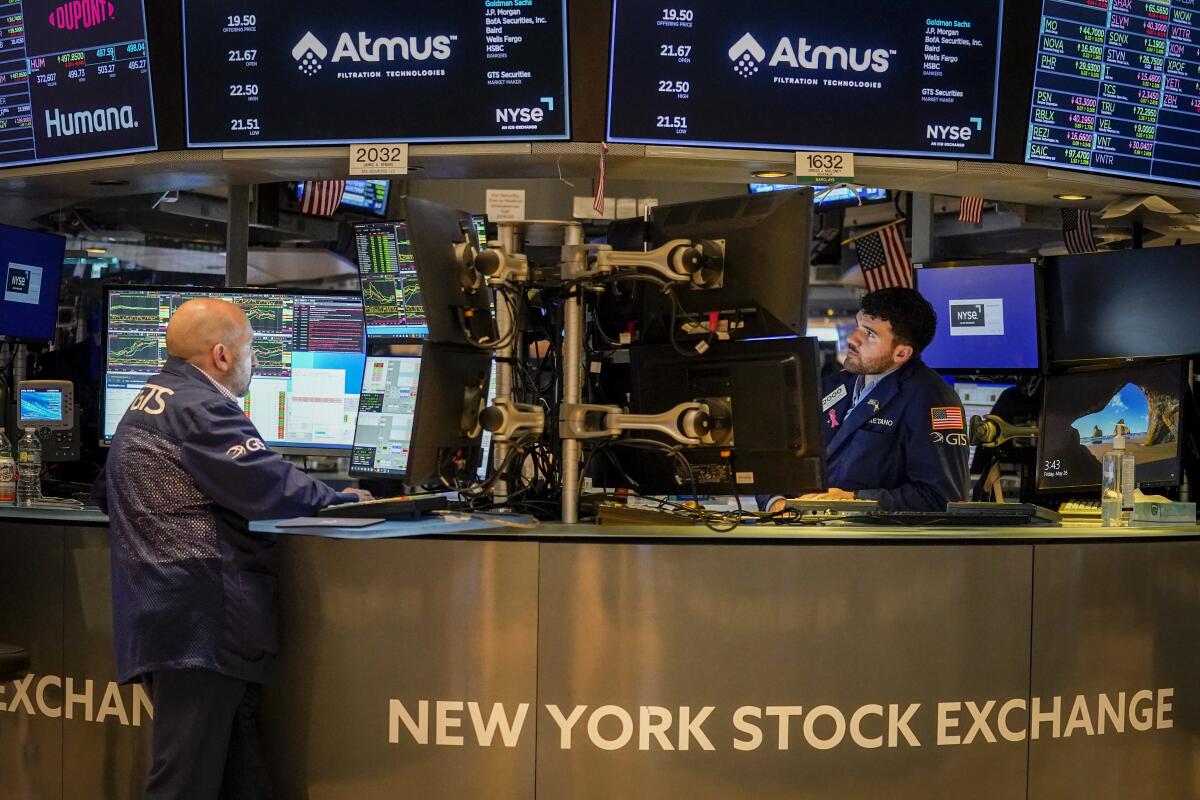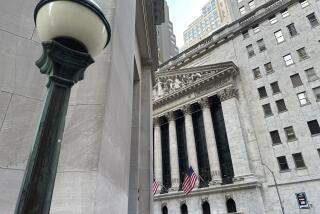Stocks fall on Wall Street after 10-year Treasury yield climbs to the cusp of 5%

- Share via
Wall Street fell Thursday as it faces the prospect of a 5% yield on the 10-year Treasury for the first time since 2007.
The Standard & Poor’s 500 lost 36.60 points, or 0.8%, to close at 4,278.00 after a mixed set of profit reports from Tesla and other influential companies. The Dow Jones industrial average dropped 250.91 points, or 0.7%, to 33,414.17, and the Nasdaq composite sank 128.13 points, or 1%, to 13,186.18.
Stocks felt pressure from the bond market, where rapidly rising yields have been squeezing Wall Street since the summer. The yield on the 10-year Treasury touched 4.99%, up from 4.91% late Wednesday, before paring its gain to 4.98%. As the reference point for much of the financial world, the 10-year yield helps set prices for all kinds of investments and loans.
Yields swung after the Federal Reserve’s chair said again that the central bank will watch how the economy and inflation trend before making upcoming decisions on interest rates. It’s already pulled its main overnight interest rate to the highest level since 2001, and the 10-year Treasury yield has been catching up.
The 10-year yield has been on a mostly steady march up from less than 3.50% during the spring as a resilient U.S. economy forces investors to accept a new normal in which the Federal Reserve probably will keep its main interest rate high for a long time.
As Rite Aid restructures its debt in Chapter 11 bankruptcy, it will close 154 locations in 15 states, including 31 in California.
Fed Chair Jerome H. Powell said in a speech Thursday that if growth for the U.S. economy appears persistently strong, that could push the Fed to raise rates further. But he also noted that the recent rise in longer-term bond yields, such as that of the 10-year Treasury, has been doing some of the Fed’s work for it by slowing the economy without requiring additional hikes.
The Fed is raising rates in hopes of curtailing spending across the economy and damping inflation. A higher 10-year yield makes mortgages more expensive, knocks down prices for investments and makes it costlier for companies to borrow and grow.
“That’s how monetary policy works, that’s literally how it works,” Powell said about how the Fed’s tightening monetary policy has led to higher yields, which should hopefully take pressure off inflation.
Another report came Thursday to show the U.S. job market remains remarkably solid, even though the Fed has already pulled its main rate to the highest level since 2001. Fewer U.S. workers applied for unemployment benefits last week than expected, which indicates low levels of layoffs across the country.
While that’s good for an economy that has defied predictions of a recession, it could also add upward pressure on inflation.
A separate report, though, said manufacturing in the mid-Atlantic region is weakening by more than economists expected. And a third report said sales of previously occupied homes fell last month, though not by as much as economists expected. Mortgage rates have climbed to their highest levels since 2000.
What happens next with yields and the value of the U.S. dollar will depend on whether the U.S. economy can indeed pull off what’s called a “soft landing,” in which growth slows enough to snuff out inflation but not so much that it causes a bad recession. It will also depend on how sticky inflation is aftger that landing, said Athanasios Vamvakidis, foreign-exchange strategist at Bank of America.
The Federal Reserve left its key interest rate unchanged for the second time in its last three meetings, a sign that it’s moderating its fight against inflation.
Vamvakidis wrote in a BofA Global Research report that he sees risks of yields and the dollar remaining high after the landing, even if they’re both lower than current levels.
High yields hurt all kinds of stocks, but especially those bid up for big growth that’s expected far in the future or those seen as very expensive. That has often put the spotlight on large tech companies recently, and some reported a mixed set of profits.
Tesla fell 9.3% after it reported weaker results for the summer than analysts expected. It’s been cutting prices to drive sales, but that also eats into its profitability.
Zions Bancorp. tumbled 9.7% even though it reported stronger profit than expected for the latest quarter. It and other banks smaller in size than the industry’s biggest titans struggled earlier this year after high interest rates helped cause three high-profile bank failures.
On the opposite end was Netflix, which jumped 16.1%. It reported stronger profit for the latest quarter than analysts expected, and it said it would raise prices on some of its membership levels to drive more revenue.
Los Gatos, Calif.-based streaming giant Netflix added more subscribers than expected, thanks to popular new and old content (“Suits”) and a crackdown on password sharing.
American Airlines rose 0.8% after reporting stronger profit than expected for the busy summer season. It had dropped sharply a day before, when United Airlines warned that high fuel prices and the suspension of flights to Tel Aviv would eat sharply into its profits at the end of the year.
Overall, analysts expect companies across the S&P 500 index to report slight growth in their earnings per share for the summer versus a year earlier. If they do, it would be the first such growth in a year.
Crude oil prices, meanwhile, rose further after erasing losses from the morning. A barrel of U.S. crude for November delivery jumped $1.05 to settle at $89.37. Brent crude rose 88 cents to $92.38. A day earlier, both jumped at least $1.60 on worries that the war in the Middle East could lead to disruptions of supplies.
In stock markets abroad, indexes fell across Europe after slumping more sharply across Asia.
AP writers Matt Ott and Elaine Kurtenbach contributed to this report.
More to Read
Inside the business of entertainment
The Wide Shot brings you news, analysis and insights on everything from streaming wars to production — and what it all means for the future.
You may occasionally receive promotional content from the Los Angeles Times.











